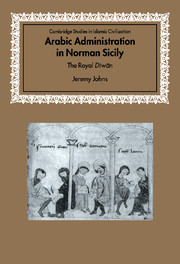Book contents
- Frontmatter
- Contents
- Preface
- Tables
- Abbreviations
- Genealogical table of the De Hautevilles of Sicily
- Note on Measurements
- Introduction
- 1 ‘In the time of the Saracens …’
- 2 ‘When first the Normans crossed into Sicily …’
- 3 ‘Our lady, the Regent Adelaide, and our Lord, the Count Roger, her son’, 1101–30
- 4 The earliest products of the royal dīwān, 1130–43
- 5 The jarāʾid renewed, 1144–5
- 6 The records of the royal dīwān. Part I: the jarāʾid al-rijāl
- 7 The records of the royal dīwān. Part II: the dafātir al-ḥudūd
- 8 The duties and organisation of the royal dīwān, 1141–94
- 9 ‘The people of his state’. The ‘palace Saracens’ and the royal dīwān
- 10 The Norman dīwān and Fāṭimid Egypt
- 11 Royal dīwān and royal image
- Appendix 1 Catalogue of dīwānī documents
- Appendix 2 Provisional catalogue of private documents
- Appendix 3 Abū Tillīs – ‘Old Wheat-sack’
- List of References
- Index
- Titles in the series
Appendix 1 - Catalogue of dīwānī documents
Published online by Cambridge University Press: 10 March 2010
- Frontmatter
- Contents
- Preface
- Tables
- Abbreviations
- Genealogical table of the De Hautevilles of Sicily
- Note on Measurements
- Introduction
- 1 ‘In the time of the Saracens …’
- 2 ‘When first the Normans crossed into Sicily …’
- 3 ‘Our lady, the Regent Adelaide, and our Lord, the Count Roger, her son’, 1101–30
- 4 The earliest products of the royal dīwān, 1130–43
- 5 The jarāʾid renewed, 1144–5
- 6 The records of the royal dīwān. Part I: the jarāʾid al-rijāl
- 7 The records of the royal dīwān. Part II: the dafātir al-ḥudūd
- 8 The duties and organisation of the royal dīwān, 1141–94
- 9 ‘The people of his state’. The ‘palace Saracens’ and the royal dīwān
- 10 The Norman dīwān and Fāṭimid Egypt
- 11 Royal dīwān and royal image
- Appendix 1 Catalogue of dīwānī documents
- Appendix 2 Provisional catalogue of private documents
- Appendix 3 Abū Tillīs – ‘Old Wheat-sack’
- List of References
- Index
- Titles in the series
Summary
COUNT ROGER I
1. [1093 a.d.] 6601 a.m., Indiction I [1 January to 31 August]. Mazara.
An unknown number of plateiai issued to Roger I and his barons. In the Greek conclusion to Dīwānī 4, Roger refers to ‘the plateiai of my own lands and of my barons, which were written at Mazarra (sic) in the year 6601 [a.m. = 1093 a.d.], in Indiction I'. They are mentioned again in Dīwānī 21–2 as ‘the jarācjs1705 id which were written at Mazara two years earlier’ [i.e. than Dīwānī 3–4]. All seem to be lost, but see Dīwānī 5.
Pp.54 note 111, 59–60, 144, 281.
2. [1095 a.d.] 12 February. Palermo.
A Greek donation and plateia in which Count Roger I grants to the cathedral church of Santa Maria di Palermo ninety-five households of ‘Hagarenes’, together with their lands, amounting to eleven ‘ox-lands’, in the districts of Iato, Corleone, and Limonos (i.e. near Maganoce, Arabic Maghanūja, 3km south of modern Piana degli Albanesi). The Hagarenes were to pay to the church a collective tribute of seven hundred and fifty tarì twice a year, in August and during the winter, and, again collectively, one hundred and fifty modia of wheat and the same amount of barley. The Greek privilege incorporates both an Arabic jarīda of seventy-five villeins, and a Greek katonoma of their twenty neokamoi (sic for neogamoi).
- Type
- Chapter
- Information
- Arabic Administration in Norman SicilyThe Royal Diwan, pp. 301 - 314Publisher: Cambridge University PressPrint publication year: 2002

